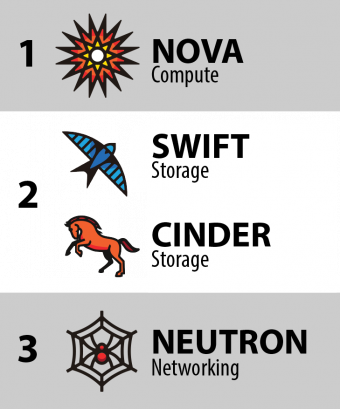It can be a bit intimidating when you’re new to OpenStack. Here are a few tidbits to help kick-start your journey.
What is OpenStack?
Think of OpenStack as an open-source, cloud infrastructure management system used to automate and control large pools of compute, storage, and data center resources. Various flavors of OpenStack are also available, including enterprise-grade options that offer services such as support, upgrades, and APIs for vendor-specific ecosystems.
The OpenStack Project itself is a collaborative development initiative whose goal is to produce the open standard cloud platform for public and private clouds. A collective group of global developers and technologists collaborate on OpenStack projects throughout the year and meet every every six months at OpenStack summits where they share lessons learned, gather requirements, discuss features, and collaborate for upcoming releases.
OpenStack Summits
The most recent OpenStack summit was held in Boston in May, and the next will be in Sydney on November 6-8. Over 5,000 attendees representing about a thousand companies from 63 countries attended the Boston summit. So yeah, be sure to tell your boss that all the cool kids go when you make your case for travel. Details of the Sydney summit are available at https://www.openstack.org/summit/sydney-2017/.
Over 700 sessions were offered at the Boston summit. Unless you’re a time traveler, there’s no way to attend them all. Not all sessions are recorded, but the OpenStack Foundation does make a good number of them available online. Boston’s video repository can be found at: https://www.openstack.org/videos/summits/boston-2017.
OpenStack initiatives
The OpenStack Foundation promotes the advancement of OpenStack, serving the OpenStack community (developers, users, service providers, vendors, etc.) and providing shared resources for the entire ecosystem organized around three major aspects of virtualization.

The compute service, Nova, involves provisioning and managing large networks of virtual machines (VMs).
The storage service, Swift, involves (object or data) storage, while Cinder involves block storage for servers and applications.
The networking service, Neutron, is an software-defined-networking project focusing on delivering networking-as-a-service (NaaS).
There are actually more than 60 OpenStack Projects under development, and each has been assigned its own project mascot. You can see them all at https://www.openstack.org/project-mascots.
Random OpenStack facts: Releases
OpenStack releases typically occur every six months. The latest release, Ocata, broke the mold with a four-month development cycle. And while Ocata was released only this past February, the forthcoming releases have already been named. Pike is on deck, to be followed by Queens.
Release names are also associated with nearby cities, counties, or distinguishing regional features of the summit corresponding each OpenStack release. For example, the Ocata release is named after a beach in El Masnou, Spain, just a short drive from where the 2016 summit was held. It’s also rated #1 on TripAdvisor among 13 attractions in that area.
There are other special rules associated with release names that mandate creativity from the OpenStack Foundation members. In addition to the alphabetical order requirement, the name must be a single word with a maximum of ten characters and must not describe the feature. “Ocata Beach,” for example, wouldn’t meet those requirements. For more information on the rules of release naming, visit https://wiki.openstack.org/wiki/Release_Naming
OpenStack adoption
Hundreds of the world’s largest brands run on OpenStack. Its adoption spans multiple industries. Automotive, finance, media, energy, and telecom are just a few examples. 50 percent of Fortune 100 companies have deployed it — and adoption is still growing.
OpenStack is particularity critical to the strategies of many Tier 1 service providers. In North America, AT&T’s Integrated Cloud (AIC) and Verizon’s universal CPE (or cloud-in-the-box) are both examples worth noting.
Stay tuned for OpenStack Cramming, Part II…
Beverly Ibarrola is director of strategic partnerships, SDN and NFV at Award Solutions. This post first appeared on LinkedIn.
Superuser is always interested in community content – get in touch at editorATopenstack.org.
- OpenStack Cramming, Part I - June 29, 2017

)












